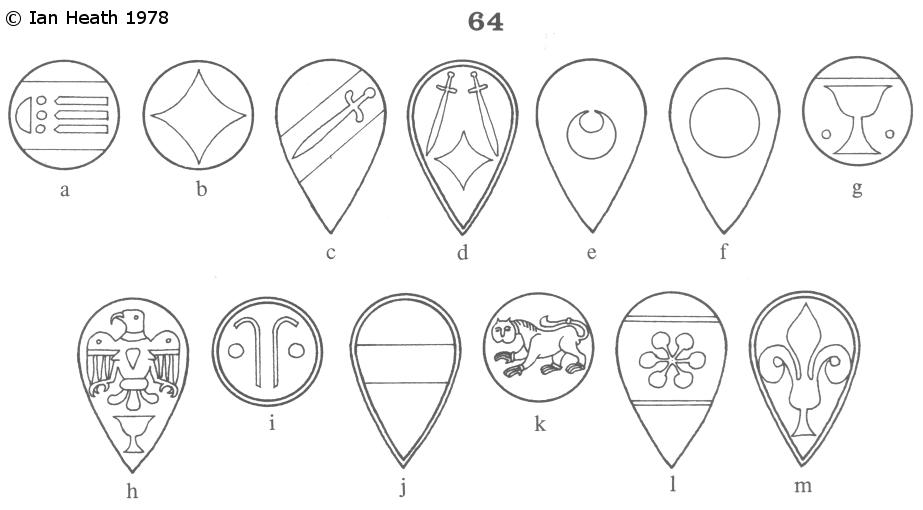
Try Amazon Audible Plus
SARACEN HERALDRY
An extract from Armies and Enemies of the Crusades 1096-1291by Ian Heath



64. SARACEN HERALDRY
In the Moslem world heraldry played only a secondary role amongst the military elite. Only Sultans and amirs could have heraldic devices, Qalqashandi recording that it was customary for every amir to have a special blazon 'according to his choice and preference.' Such devices were hereditary only to such descendants as followed military careers. They were probably originally granted by the Sultan himself and usually represented the office which the bearer had held at the time that he was made an amir. Abu'l Fida, writing in the early 14th century, records that 'the Secretary's emblem is the pen-box, the Armour-bearer's the bow, the Superintendent of Stores' the ewer, the Master of the Robes' the napkin, the Marshal's the horseshoe, and the Jawish a golden saddle.'
64a-m represent a variety of Syrian and Egyptian devices as used by the Ayyubids and early Mamluks.
64a is the pen-box of the Secretary, 64b the napkin of the Master of the Robes, and 64c and d the sword of the Armour-bearer, the latter also including a napkin. As mentioned by Abu'l Fida, the Armour-bearer's device could also be a bow (sometimes accompanied by arrows), or even a crossbow, though no examples of the latter survive. 64e is a device usually described as a crescent, though in his 'Saracenic Heraldry' L. A. Mayer plausibly suggests that it is a Saracen horse-shoe, and therefore the device of the Marshal (see also note 57).
There were also other officers' devices not listed by Abu'l Fida, for instance the table of the Taster (64f) and the cup of the Cup-bearer (64g and h), one of the most common devices in Saracen heraldry. Other devices indicative of their bearers' offices were polo-sticks (Polo-master, 64i), standard ('Alamdar, or Standard-bearer), drums and drumsticks (Tabldar, or Drummer) and horn. 64j, a device very common amongst the 13th century Bahriyyah Mamluks, Mayer suggests as the device of the Dispatch-rider.
Animal devices were unusual, and the only animals to appear in Saracen heraldry are the lion, the eagle and occasionally the horse. The most famous during this period was the lion of Sultan Baibars (64k), and one source speaks of Saladin's standard and that of his brother el-Afdal as carrying pairs of lions at Acre in 1191. However, Saladin's device may have been an eagle, a device which appears to have been particularly popular amongst the Seljuks; it was sometimes 2-headed, possibly in imitation of the 2-headed eagle adopted by the Byzantines some time during this era. Zengi and the Ortoqids appear to have used this device. The banner of the vizier Fakr ad-Din, the Moslem commander at El Mansurah, also bore an eagle.
64l and m were also popular during this era. 64l, usually described as a rosette, was a common device under both Ayyubids and early Mamluks, usually 6-pointed as here but sometimes with 5 or 8 points. The fleur-de-lis (64m) was the device of Nur ed-Din and also features on a large number of Ayyubid coins. The Saracen fleur-de-lis differs slightly from that used in Frankish heraldry in that the 3 leaves grow from a common stem; in Frankish heraldry the leaves are individual and are joined together only by a hand in the middle.
Some other devices represented Tamghas, the tribal symbols used as brands by many Asiatic peoples and introduced into the Near East by Turkish mamluks.
From the evidence of surviving examples it would appear that the colours used in Saracen heraldry consisted of white, yellow, red, blue, green, brown and black. The formal regulations of European heraldry, forbidding the use of certain colours together, do not appear to have applied.